#Sony Music France
Photo
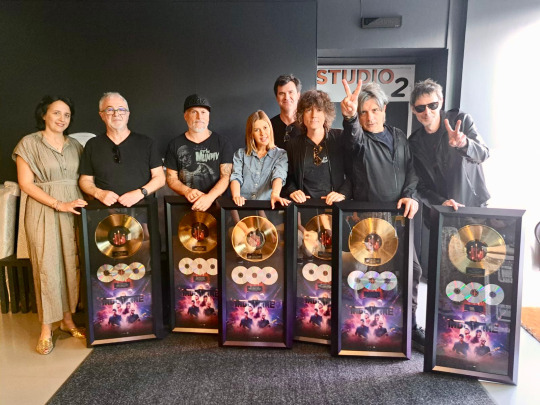

Hier, remise du disque d’or et vidéo triple platine pour Central Tour - le film, avec toute l’équipe de Sony Music.
Merci à tous !
#Indochine#Central Tour#Central Tour le film#Nicola Sirkis#Oli de Sat#Boris Jardel#Marc Eliard#Ludwig Dahlberg#Sony Music France#RCA Records#Sony Music#Indochine Records
16 notes
·
View notes
Text
New Audio: Ian Asher's Remix of JAIN's Infectious, Smash Hit "Makeeba"
New Audio: Ian Asher's Remix of JAIN's Infectious, Smash Hit "Makeeba" @Jainmusic @ColumbiaRecords @sonymusic @SonyMusicFr @IanAsherMusic
French-born with international pop sensation JAIN is a true international citizen: She has spent significant portions of her live in the United Arab Emirates and the Democratic Republic of the Congo. Her full-length debut 2016’s Zanaka quickly put her on the global pop map: The album sold over one-million copies worldwide, with singles “Come” and “Makeba” climbing the charts. Adding to a growing…

View On WordPress
#AIN The Fool#electro pop#Ian Asher#indie electro pop#inide pop#JAIN#JAIN Makeeba#JAIN Souldier#JAIN Zanaka#New Audio#singer/songwriter#Single Review#Single Review: JAIN Makeeba (Ian Asher Remix)#Single Review: Makeeba (Ian Asher Remix)#Sony Music France#women who kick ass
0 notes
Text

Garou in Lille on 5 of January … what a great show. 🤩

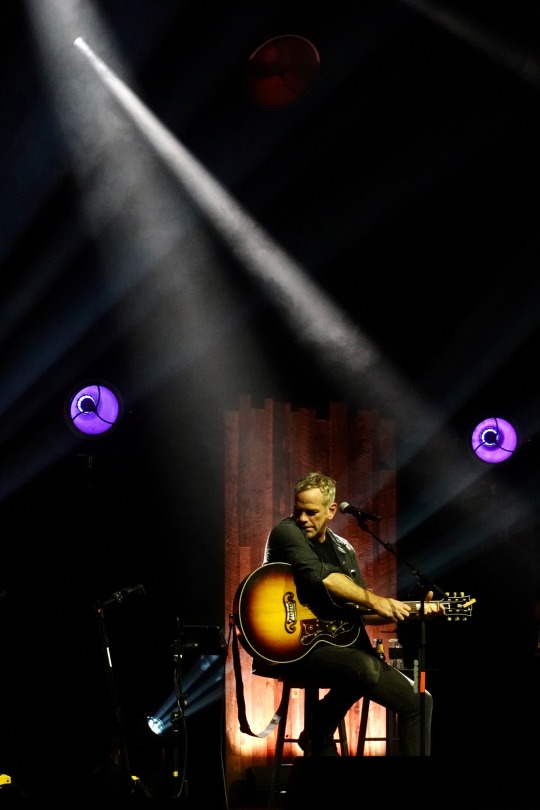

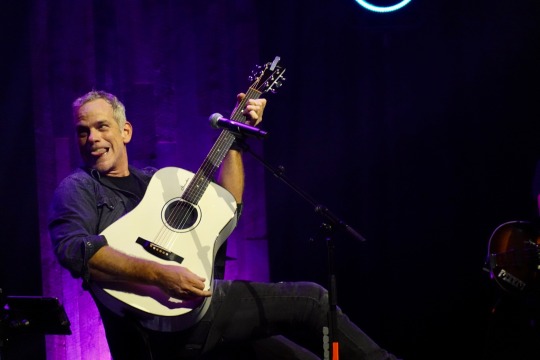




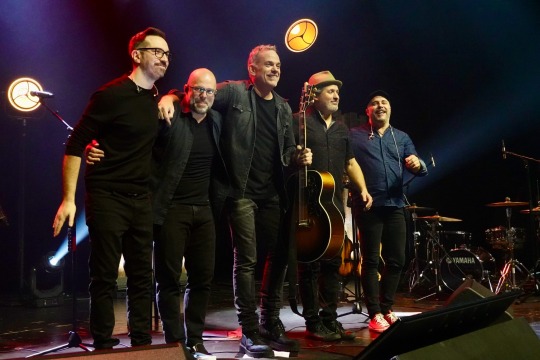
#Garou#garou joue dassin#lille#france#Lille Grand Palais#concert#music#musique#garou tourne#gig photography#concertphotography#concert photography#concert photos#concertphotos#frankreich#sony#sony rx100#Sony rx100vii
1 note
·
View note
Text
ATTENTION CORPO BLOGS. I need everyone pronouns for my fic so like just reblog with your pronouns please
tags
@totally-bing @totally-official-yahoo @totally-microsoft @the-true-internet-explore @the-tumblur-searchbar @the-real-google @subway-offical @speedway-official-unofficial @realsafari @official-fedex @samsung-music-official @nasa-real @yahoo-official @waffle-house-unofficial @the-official-apple @im-pandora-i-promise @the-tumblur-searchbar @us-costco-official @america-runs-on-dunkin @burger-king-unofficial @burgerking-official @yandex-search-fr @duothelingo @tim-hortans-official @indisputably-ihop @definitely-wikipedia @the-one-and-only-duckduckgo @firefox-official @youtube-music @totally-geico @actually-amazon @whataburger-unofficial @definitely-tor-browser-official @yahooo-official @undeniably-chevron @jack-in-the-box-official @bingle-official @walmart-the-official @disney-the-official @totally-mcdonalds @costa-official @asda-real
@totally-real-quotev-promise @the-real-twitter-bird @real-target @x-official @centers-for-disease-control @the-real-honda @bonafide-browser-brave @totally-germany @true-opera-gx@operagxreal @amazon-officialblog @the-mcdonalds @barnes-and-noble-official @official-the-united-states @russia-totallyofficial @scotland-forever @totally-france @officialtheunitedkingdom @genuinely-germany @claires-unofficial @real-firefox @real-vivaldi-browser @chick-fil-a-unofficial @the-actual-real-android @the-real-ups @applebees-honestly @pub-subs-forever @big-mayo-official @fr-winn-dixie @i-swear-im-nokia @tgi-thursdays @def-bjs-guys @sony-official @the-mcdonalds @mcdonalds @totallyinnout @speedron @firehouse-subs-fr @unofficial-ihop @mcgeese @unofficial-copilot @asda-real @clippy-unofficial @costa-official @definitely-quicktrip @definitely-spencers-gifts @im-the-real-roblox-i-swear @incognito-mode-official @its-target-official @jollibee-real @kfcfingerlickingood @krita-the-artprogram @not-really-discord @officially-ikea @pinterest-real @real-sephora @the-official-princess-club @the-real-honda @acually-history
178 notes
·
View notes
Text
hello corpo blogs
@totally-bing
@totally-official-yahoo
@totally-microsoft
@the-true-internet-explorer
@the-tumblur-searchbar
@the-veryreal-edge
@the-real-spotify
@the-real-google
@subway-offical
@speedway-official-unofficial
@realsafari
@official-fedex
@apple-music-official
@samsung-music-official
@nasa-real
@yahoo-official
@waffle-house-unofficial
@the-official-apple
@im-pandora-i-promise
@the-tumblur-searchbar
@us-costco-official
@america-runs-on-dunkin
@burger-king-unofficial
@burgerking-official
@yandex-search-fr
@duothelingo
@tim-hortans-official
@indisputably-ihop
@definitely-wikipedia
@the-one-and-only-duckduckgo
@firefox-official
@youtube-music
@totally-geico
@actually-amazon
@whataburger-unofficial
@definitely-tor-browser-official
@yahooo-official
@undeniably-chevron
@jack-in-the-box-official
@bingle-official
@walmart-the-official
@disney-the-official
@totally-mcdonalds
@costa-official
@asda-real
@totally-real-quotev-promise
@the-real-twitter-bird
@real-target
@x-official
@centers-for-disease-control
@the-real-honda
@bonafide-browser-brave
@totally-germany
@operagxreal
@amazon-officialblog
@the-mcdonalds
@barnes-and-noble-official
@official-the-united-states
@russia-totallyofficial
@scotland-forever @totally-france
@officialtheunitedkingdom
@genuinely-germany
@claires-unofficial
@real-firefox
@real-vivaldi-browser
@chick-fil-a-unofficial
@the-actual-real-android
@the-real-ups
@applebees-honestly
@pub-subs-forever
@big-mayo-official
@fr-winn-dixie
@i-swear-im-nokia
@tgi-thursdays
@def-bjs-guys
@sony-official
115 notes
·
View notes
Text
Paul and Linda, a collection of PDAs: Part 1 - Kisses
In our walk down the memory lane of Paul and Linda’s love story, which still captivates the romantics and the expressive artists out there, we start with an excerpt of an interview.
Rolling Stone cover June 17, 1976: “Yesterday, Today, and Paul.” In this interview, Paul says something interesting:
I mean, I kissed Linda onstage the other night, and for me, that’s kind of, ‘Wow, I must be getting real relaxed,’ ’cause I can’t do that in public, normally. I’m a bit kinda shy.
Paul McCartney shy about showing affection? Well, artists are certainly a different breed. He can sing a heartfelt love song in a venue full of people, but has to work up the courage to give his wife a little kiss? As photos will tell, he soon got over that quirk.
And even before this RS interview, he could certainly be demonstrative when a photographer or videographer was around, whereas the average person would be more guarded knowing that their tender moment would soon be out there as a picture in a magazine or a video clip on TV (we’re talking pre-internet days here).
RS Interview from The Paul McCartney Project
The 1970s: Not Exactly in Public, but There Must Be Someone Holding The Camera
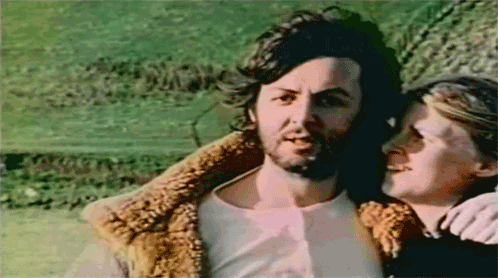
1970 or 1971. Aww, so sweet.
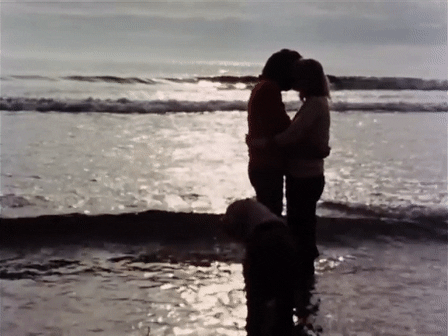
June 1971 The video for the song “Heart of The Country” was made in Scotland. Is that a kiss? We might have to examine the still pic below.
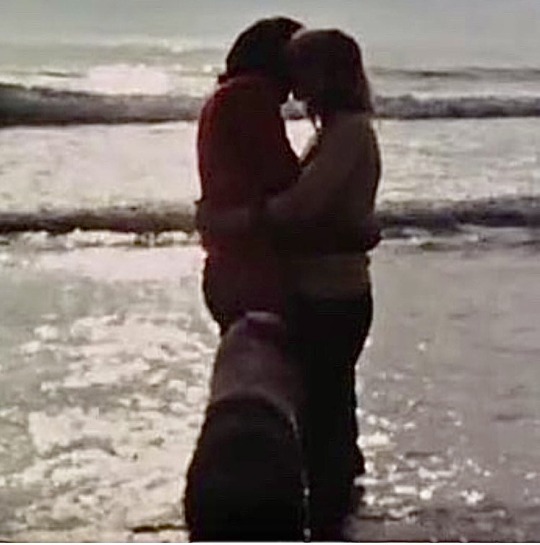
June 1971 A still image from the “Heart of The Country” video. I’ll count this as a kiss.

1974 In the garden of their house with baby Stella between them. It’s a published pic, so I’m counting it as a public kiss. (An “almost-kiss” but close enough.)
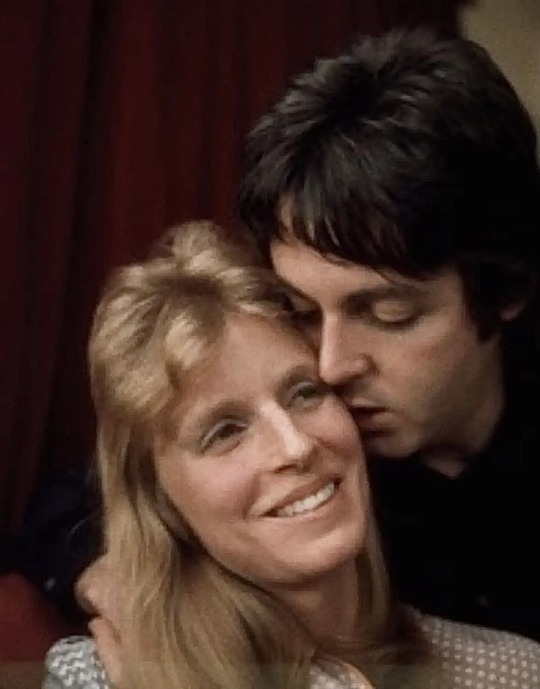
1974 Photoshoot for the Apr. 7, 1974, issue of New York News magazine. The cover story was "Just an Old Fashioned Beatle: An Exclusive Visit with Linda and Paul McCartney." Aww, lips softly touching the cheek is something I’m going to classify as a kiss.
Magazine article: @johnflyons.beatles on instagram
Post-1970s: Now We’re Really in Public
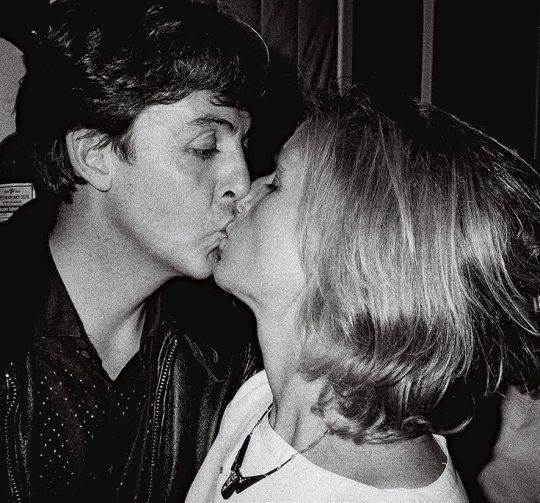
Sept. 21, 1982, at Linda's first photography exhibition in London. Photo © Robert Rosen. Rosen talks about the snap in this excerpt from an interview with I-D magazine:
What's one photo you're really proud of?
Robert Rosen: I love the shot of Paul and Linda McCartney kissing. As soon as I had it developed I just thought, wow, I did that. I sent them a print but didn't hear anything more until a few months later, when, Paul and Linda turned up to a gallery event I happened to be at. At one point, Linda tapped me on the shoulder and said, 'Are you ignoring us?' She gave me a big hug and told me they loved the photo. That obviously meant a great deal to me.
From The Guardian archive, 21 September 1982: First London exhibition for Linda McCartney
I-D Interview with Robert Rosen Sept. 20, 2017

November 26, 1982, in Paris, France during photography month. An exhibition of Linda’s photographs was part of the event. Okay, his lips are just grazing her hair, so I’m going to call this a “hair kiss.”

Feb. 8, 1983 The 1983 British Record Industry Awards. Paul gets a congratulatory kiss from Linda after winning the 1982 British Male Solo Artist award and the Sony Trophy Award For Technical Excellence. The Beatles won the Outstanding Contribution to Music award.
More pics: The Paul McCartney Project

The same 1983 British Record Industry Awards. Two kisses in one night! Paul can’t hide his surprise.

Nov. 28, 1984 Another congratulatory kiss from Linda as Paul is presented with the Roll of Honorary Freedom of the City of Liverpool.

October 16, 1986 British Video Awards at Grosvenor House Hotel, London.
Rupert and The Frog Song awarded the Best Selling Video of 1985
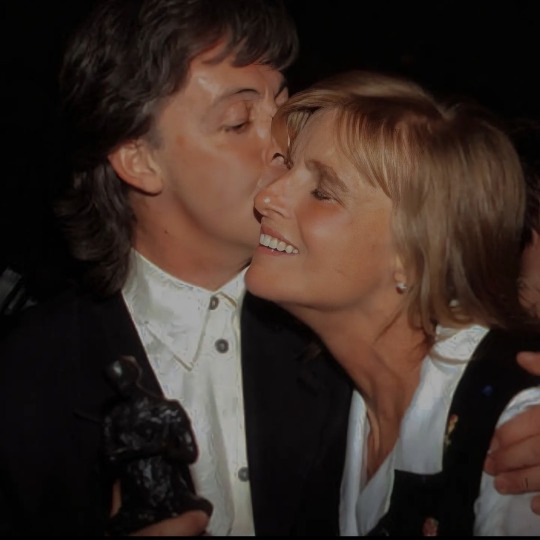
April 4, 1989 Ivor Novello Awards at The Grosvenor House Hotel. Paul wins, Linda gets a kiss (so they both win 😊).

July 29, 1990 Backstage during the Paul McCartney World Tour 89/90 at Soldier Field Chicago. Linda is bidding farewell to Paul as she heads for the dressing room and he to the press tent.
From I Saw Him Standing There, Jorie B. Gracen, 2000. @thebeatlesofoz2 on Instagram
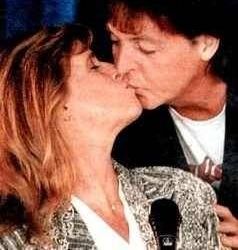
April 27, 1994 Press Conference for Linda's Home Style Cooking at Beverly Wilshire Hotel in Beverly Hills, California. Paul comes out to endorse Linda’s book, and greets her with a kiss.
Video clip of Paul’s entrance from CelebrityFootage.com
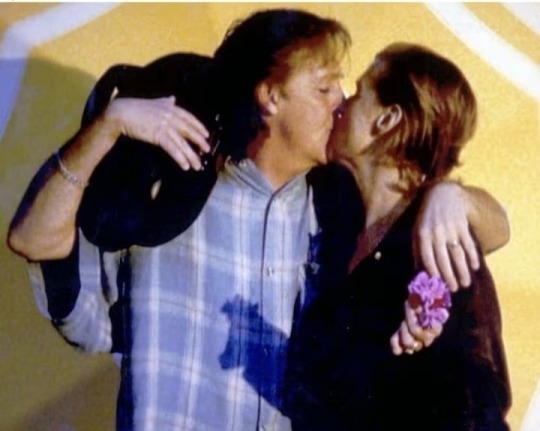
1997 from the video for the song “The World Tonight”
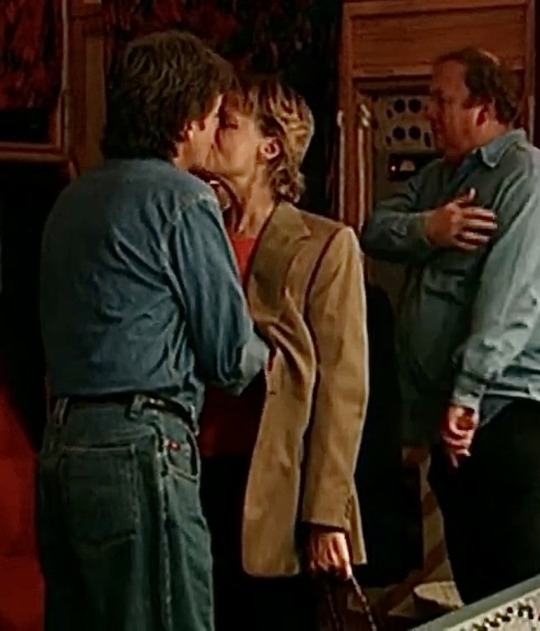
1997 A kiss in the studio, from the documentary In The World Tonight.
Let’s see the whole sequence of that kiss, right from the beginning:



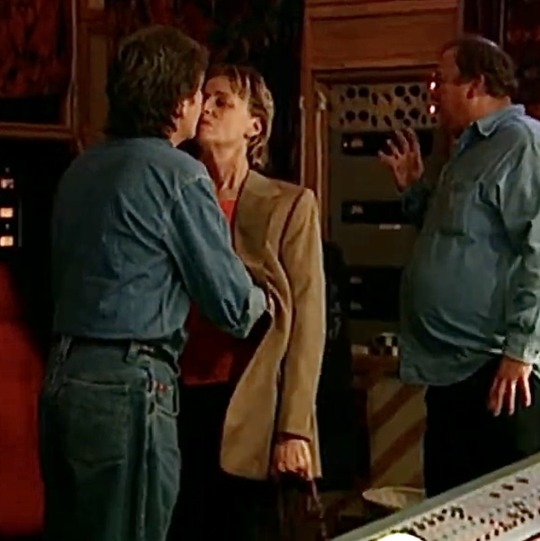
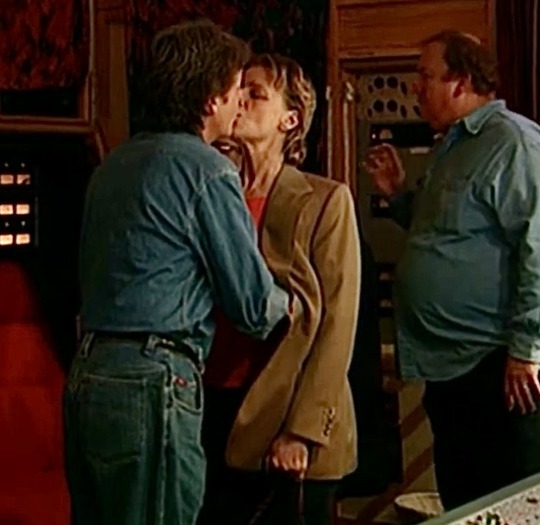
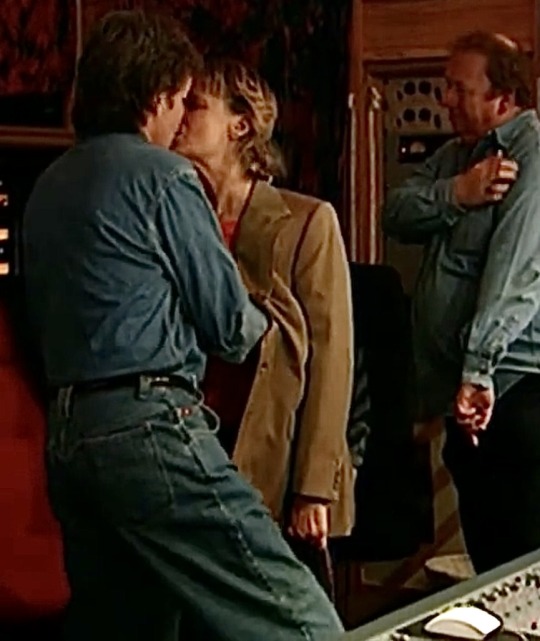


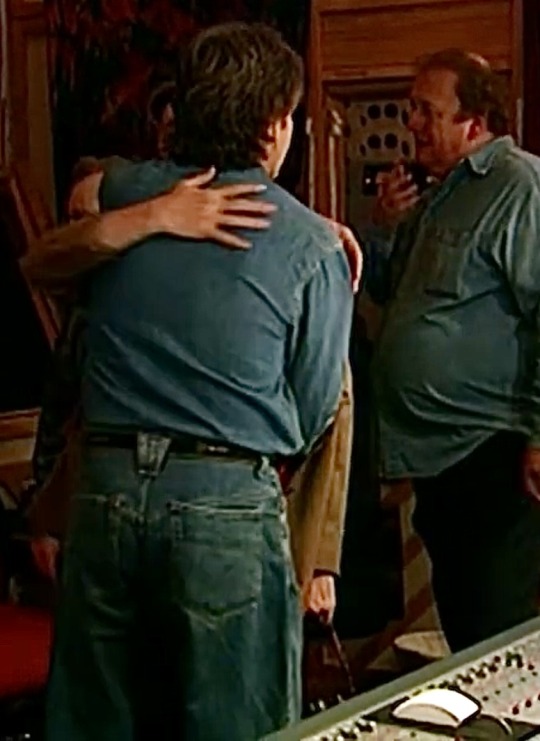
Bonus: Wedding Kisses March 12, 1969
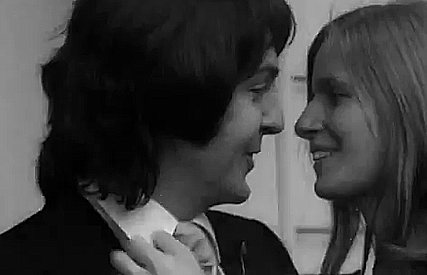
You go Linda! Give your groom a kiss like the cameras aren’t around.

Everyone’s relationship dream: Get someone to look at you the way Linda looks at Paul here.
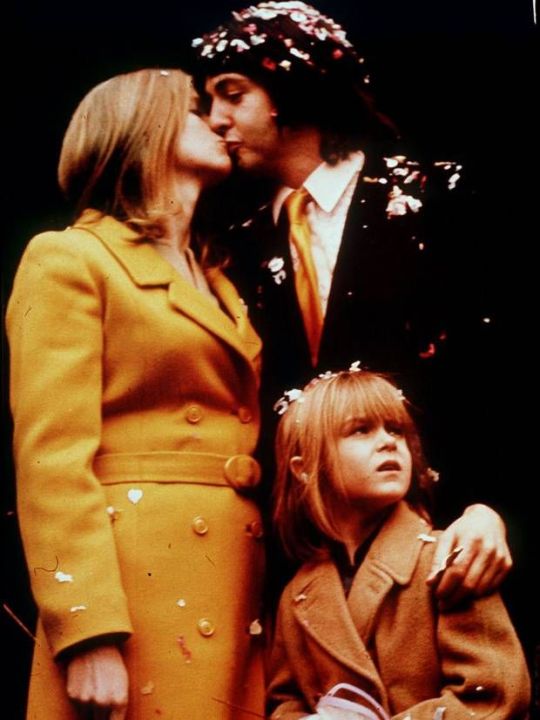


#Youtube#paul mccartney#linda mccartney#linda and paul#paul and linda romantic#paul and linda mccartney#paul and linda forever#linda louise mccartney#linda mccartney and wings#linda eastman mccartney#paul and linda#lovely linda
68 notes
·
View notes
Note
Remember that time when Louis broke his arm and Larries made weird shit as if he did it on purpose. He had to have surgery but he still didn’t cancel the signings he did for fans. He did it even though his arm was sore and stiff.
He was nice to everyone. He had a kind word for everyone who came. He went from city to city too. The Larries still don’t appreciate Louis’ work ethic. They compare him to Harry who would rather hangout with a bunch of celebrities and have press releases for how kind he is for sending the famous people flowers.
Not one UK radio DJ spoke about how Louis still does these things for fans which he doesn’t have to, things like meeting fans for free outside his venues. If Harry did anything like that Rolling Stones would be writing articles about how Harry is setting standards for how to treat fans. There is no nicer celebrity than Harry. He should get a gold star.
That is basically the difference between when image is built for you without doing anything versus when you are actually doing a lot of stuff but the industry won’t ever acknowledge you.
I think there are Larries who have a double standard for Harry and Louis because they have a deepseated belief that Harry deserves everything good, but somehow Louis must earn anything good.
Hence Larries tend to doubt Louis’ words, accuse him of lying, assume he’s lazy, believe Niall and Liam when they say that Louis was lying around drinking and smoking during the pandemic. He must have been hiding in Jeff Azoff’s house with Harry eh? Remember the dog barking in Harry’s interview, that they all joked was Clifford? Because of course Louis would charter a plane in a pandemic to bring a dog across the continent for Harry.
(In actuality, Harry was busy getting papped with Rande Gerber and Kendall Jenner in LA, driving in France and Italy visiting restaurants. He recorded Harry’s House. Sony blitzed his songs on streaming and radio platforms to get him numbers, awards. Louis was writing Faith In The Future— and released at least 21 songs for the second album. He was organizing Live From London, setting up AFHF 2021, and filming All Of Those Voices. He set a world record. Louis’ first concert after the pandemic was a FREE event for 8k fans, something that none of the other 1D guys have ever matched. So much for laziness.)
Then I think there are Larries who know that the double standards come from industry bullshit, but they brainwash their followers anyway.
These are the Larries who say, “When I see Louis doing something bad, I’m going to call it out,” but what they mean is when Louis talks about Freddie or when he calls out Larries’ atrocious behavior. They’re not fans of Louis’ music, lifestyle, friends, family, fashion, achievements, mannerisms, speech. They don’t go to his concerts and they frequently call for boycotts. They don’t listen to his music. They haven’t watched AOTV, and criticize the bits they’ve seen. They also don’t have any real criticism for Harry Styles. They parrot industry critics’ harsh words about Louis.
But they recommend a lot of Larry fanfiction. They do read a lot of fanfic.
13 notes
·
View notes
Text
Tooning In 12. Greg Bailey part 3 of 10

DL:So it says on your IMDb that you directed 52 episodes of a cartoon from CiNAR called We Are the Dogs in 1985. What was that?
GB:I have no idea! I started working at Cinar in Feb. 1992. I never heard of that dog show.
DL:Oh ok. Somebody musta vandalized your account. Moving on, Starcom the U.S. Space Force for DiC and Coca Cola
GB:I remember Space Force at DIC but never heard of Coca Cola
DL:They were the syndicator of the show.
GB:I didn't know that!
DL:They had a television department called Coca Cola Telecommunications. They had a relationship with DiC during The Real Ghostbusters until the film Ishmel flopped at the box office. Causing DiC to leave the partnership.
GB:Was DIC working on Ishmel? I don't know anything about that. I am not really aware of the property. Why did they leave the work relationship over the film or did Coca Cola close up their department? Sorry I guess I have more questions than useful answers.
DL:No, DiC wasn’t working on Ishmel but yes they left their work relationship over the film.And also I'm glad you ask for answers on my knowledge.
GB:Do you know why they left over the film? It was a live action film wasn't it. I was in Japan in those years so there are a lot of things that I seem to have a lack of knowledge about what was happening on this side of the world in those years. Especially in entertainment. It took me years to see films like Robocop after hearing everyone in the US talk about them all the time.
DL:It was because their deal was soured because Coca Cola was losing money from the film, a big loss. And they sold the film distributor Columbia Pictures to current owner Sony. Plus it was thought that DiC was eying a merger with Coca Cola.
GB:OK, I sort of understand now. I will have to ask around about it to see if anyone knows about it other than the executives. I believe this flop happened around 1987 if I see it correctly on Google in my quick look. DIC really went through a big upheaval at that time so it may be related. Jean Charlopin split up with Andy Heyward about that time. DIC Tokyo went with Charlopin and part of the split said that some work would be sent to DIC Tokyo for a season or 2 before DIC LA went off and did their work elsewhere. There was a lot of activity at the executive level and that ended my gig in Tokyo as well. The whole art department in LA also broke up and people went their own ways.
DL:Yep, that is correct.The ALF cartoons for Alien productions and NBC?
GB:I don't think I saw any Alf shows after they left DIC or did they end at DIC. Also Saban was part of the 3 way ownership at DIC. He bought out the music rights that DIC had and moved his company back to France. DIC really had no library to fall back on and soon had no more shows. Heyward had a lot of debt. 80 million seems to stick in my head right now and it doesn't sound like much now but with no library did it really have any value. Heyward promoted his golfing buddy Mike Moliani from director to an executive position. Mike over the years that I was there directed some pretty bad shows that were also very disorganized and had a lazy kind of pre production work done in LA. That's what I was saying last time that I would jump to do shows by Raynis because his shows were so great even if they were more challenging. The Mike Moliani directed shows were not interesting to work on as an artist and animator. It was ironic, jumping ahead 20 years later, the company I worked at Cookie Jar Toronto also bought out DIC and spent a lot of money for a company that still had no library. But I get ahead of myself.
DL:yeah. Saban bought the foreign rights to the shows only to sell them to C&D, the company of Jean Chalopin. Some jackass move.
GB:I don't know that it is a bad thing to have the rights. That's how animation companies make money. It was just questionable what Andy Heyward had after buying DiC without any rights to the music or any of the shows they made. Anyway, I am not the expert on all the executive dealings at DIC and I'm sure a lot of people have more insight than I do about that. So if Saban bought and sold the film distribution rights just to hold onto the music rights it sounds like he might have made a good financial deal pretty quickly. Sort of like flipping some real estate in a hot market.That must be how Charlopin had the rights to Gadget when they made the live action movie a decade ago.
DL:Yeah. And DiC brought Saban to court fighting with them about selling them to their former shareholder where they duke it out until it was settled in 1991 with Saban owning the rights to the pre 1990 DiC library.Revoking it from Jean Chalopin.
GB:That's funny. I believe Charlopin and Saban were old business partners at DIC France pre-LA days. I never heard that there was any bad blood between them. So I guess Saban just licensed the rights to Charlopin to make the live-action Gadget. I think they made a new animated series as well about that time. I didn't see the movie. One day I was listening to a culture critic talking about movie sequels. He said the worst movies are live-action movies based on animated tv shows. He said the Gadget movie was the worst one of those. So I guess he didn't like the movie much. I remember Bruno Bianchi's and Charlopin's names on the poster. Maybe Saban's name was there too but I didn't pay attention. I never met Saban but I had met Charlopin a few times in Tokyo just to be introduced basically.
DL:Actually they were as Saban would compose the soundtrack to Ulysses 31 and Mysterious Cities of Gold.Saban was not a producer on the film, but Chalopin and Heyward were.So how was the founder of DiC?
GB:What do you mean? "How was the founder"?
DL:Jean Chalopin,like how he was.
GB:Like I say I was only introduced to him briefly. He was kind of a nice-looking and amiable person from my brief meeting. He looked like someone very comfortable in his skin and well-suited to the jet-set lifestyle he was living. He was still quite young then. I would guess in his late 30's/ maybe 40 so he was an early boomer. I saw him last around the time the company was breaking up and he had come to Tokyo I guess to meet with Katayama and Bruno and discuss what the plan was.
DL:C.O.P.S. for Hasbro?How was working on that show?
GB:I think everyone in DIC must have worked on that series. It was another syndicated series of 65 shows so as usual they went through the studio at breakneck speed and the quality of syndicated shows was much lower than network Saturday morning shows. I didn't love the show much because it was kind of macho adolescent stuff with not much story value and no humor. I guess if you like that kind of thing it was fine but I never really liked the natural human-looking animated characters. It just looks like bad life drawing or something and makes me remember my early days animating at Hanna Barbera. I just read a byline when I searched on Google to refresh my memory. "Cops in 2020". So I guess it was a future cop show inspired by Robocop. Part of the pre-production work was done in Canada. In Ottawa I believe, because DIC had started doing some pre-prod work in Canada by that point.
DL:Yes, it was inspired by Robocop.As Andy would try to copy trends at the time.
GB:There was some kind of immoral feeling working on shows that were glorified commercials for toys. It did weigh on you and destroyed your belief that animation should be a good thing for kids, not just something to exploit them or make them bug their parents for more terrible cheap toys.A salesman always proposes a show that was a success last year by someone else. It is counter to shows created in a more creative environment where copying something already done would be at the bottom of your list of what to do. Does that make sense? In later years working in development I would see a lot of ideas or suggestions from the sales team about making a show just like Spongebob, or just like whatever was a success last year. It is really anti-creative. But syndication was just selling toys that Hasbro was making. I guess I helped to sell a lot of toys at DIC.
DL:So how did you feel when you left DiC Entertainment in 1988?
GB:I thought my career would end because it would be hard to replace the job with something as high-paced and rewarding. It was also a matter of leaving a very financially rewarding position because we got paid well. I was going to have to leave Tokyo, which I liked a lot. Although in another way it was time for me to leave because I had put my family through 4 years of living out of a suitcase. It was time for things like school for my daughter and living somewhere that my wife could work and get on with her career. Living in Tokyo was definitely making that impossible. I didn't think I would find another job as interesting as DIC but I had learned a lot of useful skills and information about how to control a production and get more input into the show in a professional manner. A lot of skills that were not known in Canada at the time.
DL:So you worked on The Raccoons,your first Canadian production you worked on.
GB:Yes, the first after coming back from Tokyo. I was living in Ottawa for the first time and Hinton Studios was doing Raccoons. I never became much of an expert on it because my time there was short-lived before I went to Cinegroupe in Montreal. I did some Raccoons and I just started on Ren and Stimpy for a week or 2. I also did part of a storyboard on Where's Waldo in that period I believe. I don't remember how I found that job though.
DL:So at Hinton Studios, were they drawing dirty pictures of the Raccoons characters according to rumors?
GB:What?! Animators never do that.
DL:Well TV tropes said so and i just want to know to clear up rumors,that's all.
GB:I always thought those noses on the bad guys Cedric and Cyril looked kind of obscene all the time. It would be difficult to make them do anything too dirty with those flaccid noses. Come to think of it they all had droopy noses even the Raccoon characters except the females. Must have been from all those dirty scenes they were involved in that never made it onto TV that left their noses limp.
DL:Ah. so you work on the Ren and Stimpy pilot, Big House Blues. Were you working with Bob Jacques?
GB:I think I was supposed to but I only did about 2 weeks and then had to leave.
DL:How was the experience and did you like the program?
GB:Too brief to get much out of it. I was pretty excited about the design and method they were using to work. I loved the show of course and often wished I had had more time on it. The model sheets were really great and the show felt really fresh at the time.
DL:So when did you get to go to Cinegroupe in Montreal?
GB:I left to go there right after I did Ren and Stimpy for a few weeks. I was probably working the next week in Montreal and commuting back and forth to Ottawa on weekends. I had worked at Cinergroupe before going to Tokyo for a few months on Ovid and the Gang as an animator. Anyway, when I left Hinton Studios for Cinegroupe it must have been 1988 or 1989.
DL:So what was Ovide and the Gang?
GB:Ovid was a co-production with Belgium. It was an original series based on a comic book style of characters. I can't even remember what the point of the series was or the relationships between the characters. They were very cute-looking characters though and the studio was animating the whole series with about 5 animators and 5 assistants. When I went there after Hinton they were doing a few series. L'Aventure de L'ecriture a show about French grammar and a series Little Flying Bears which is just exactly as the name implies. Everything was little something or other in those years. The bears had dragonfly wings. These flying bears were saving the environment. But I guess they didn't succeed because it's still a mess. But saving the environment was big in animation in those days.
DL:So by the way, did you have cable in the late 90s early 90s? Because these shows were broadcast on The Family Channel.
GB:I do remember them on TV but don't know if it was Family Channel or CBC. I probably only had basic cable at home. I'm not sure when the series finished. Oddly it was a co-production with Yugoslavia. Unfortunately, a few years into production the Yugoslavian war began and that turned into a bloodbath. I remember before the war everyone was talking about what a fantastic place it was over there with all those people living in harmony. The breakup of the country and the massacres just went on for what seemed like more than a decade. Anyway, the show kept getting held up because the co-producing company was telling us about the tanks sitting out in front of the company and it just got impossible eventually. It's weird how all this bad stuff is going on behind the scenes in these innocent cartoons on TV.
DL:Oh yeah. Well can’t believe that the Yugoslavian war was tied to the production trouble of Little Flying Bears.Also before I go, one more question. How was it when you went to work for CiNAR and Young Robin Hood for Hanna Barbera and France Animation.
GB:I heard once that the producer over there wanted to have Cinegroupe's production money payment sent to him in a location in a neighboring country. But that didn't sit well with Cinegroupe. I don't know if they suspected he would run for it with the money and get the heck out of the way of that approaching war. It seemed like the country was unfolding in slo mo at that point. This was before the war in Kosovo and Serbia. The co-producer was in Zagreb. It was a pretty city that held the international animation festival every second year alternating with Ottawa.
DL:Interesting.
GB:Robin Hood was fine. The first job there was on White Fang. I was an animation posing supervisor. Then I did timing direction on Robin Hood. Robin Hood went by pretty smoothly and it was nice working in a familiar US production method. I was able to bring in some of those timing skills from Tokyo into the job.And then I directed a few specials on Munch. Murmel Murmel and Boy in the drawer.I think that is the correct order of work at Cinar. It was called Crayon Animation in those days but it was owned by Cinar.
DL:Wait CiNAR was called Crayon animation?Also before then CiNAR was a dubbing studio before it started to produce its own productions in 1988.
GB:Yes, the animation part of the company was called Crayon Animation. Cinar existed at a different location downtown. They did the post-prod mixing and sound work and recording at Cinar. And the executive offices of Ron and Micheline were downtown at Cinar. The animation studio Crayon was in an old industrial warehouse space in St Henri in the mid-19th century industrial part of Montreal. If you've seen the movie or read the book The Tin Flute that is where it was. Lots of rail yards and on the old Lachine canal.Yes they did the dubbing and all sound work at Cinar headquarters downtown. They owned the building there, which was originally an old convent. Later on we moved out of the Crayon building and moved to a new office tower around the corner from the Cinar headquarters and sound studio.Ron Weinberg would often talk about how he started Cinar by driving around the US with a trunk full of videotapes of the movie Wicker Man and he would sell this tape everywhere. I don't know how he did that but that was the story. I don't know if I ever saw Wicker Man but at Burning they used to burn wicker furniture in memory of that movie.
#animation#animation interview#tooning in.#dic#dic entertainment#starcom#C.O.P.S.#haim saban#saban entertainment#80s cartoons#greg bailey#the raccoons#ren and stimpy#cinegroupe#Cinar#young Robin Hood#yugoslav wars#hanna barbera
4 notes
·
View notes
Text
youtube
Thylacine - Poly (and 74 musicians)
Directed by Cécile CHABERT & THYLACINE
Director of Photography : Celidja Pornon
Camera Assistant: Emile Cervia
Director Assistant: Léna Charlon
Post production : Cécile Chabert
Production : SONY MASTERWORKS
Executive production : INTUITIVE RECORDS Management: Clarisse ARNOU Coordination: Lisa BOISSOLES
WITH
Orchestre National des Pays de la Loire, conducted by Uèle Lamore
Bravinsan Karunanithy: Piano
Maîtrise des Pays de la Loire, conducted by Pierre-Louis Bonamy
Lead Violin: Nathalie Shaw
Recorded at Le Quai, Angers by Hugo Scremin, assisted by Nicolas Erard
Mixing: Antoine Thibaudeau and Hugo Scremin
Mastering: Antoine Thibaudeau
Composer: Thylacine
Arrangements: Uèle Lamore, Antoine Thibaudeau
Thylacine ‘Poly (and 74 musicians)’
(Thylacine)
Publ. : Budde Music France / Premiere Music Group / BMG Rights Management France / R.O.A.D.S Publishing
(C) 2023 Sony Music Entertainment France SAS / XXIM RECORDS
3 notes
·
View notes
Text
Good Omens time! (Isn’t it always?) Today I read the start of the “Friday” section, when Famine gets his object of the Apocalypse, his brass scale to match War’s flaming sword. It’s a cute scene anyone who’s worked in fast-food or a customer-facing job like retail will probably appreciate. Or for that matter anyone who’s actually stepped foot in a McDonald’s; which is, you know, all of us.
Sable sauntered in to the Burger Lord. It was exactly like every other Burger Lord in America. [But not like every other Burger Lord across the world. German Burger Lords, for example, sold lager instead of root beer, while English Burger Lords managed to take any American fast food virtues (the speed with which your food was delivered, for example) and carefully remove them; your food arrived after half an hour, at room temperature, and it was only because of the strip of warm lettuce between them that you could distinguish the burger from the bun. The Burger Lord pathfinder salesmen had been shot twenty-five minutes after setting foot in France.] McLordy the Clown danced in the Kiddie Korner. The serving staff had identical gleaming smiles that never reached their eyes. And behind the counter a chubby, middle-aged man in a Burger Lord uniform, slapped burgers onto the griddle, whistling softly, happy in his work.
Sable went up to the counter.
"Hello-my-name-is-Marie," said the girl behind the counter. "How-can-i-help-you?" "A double blaster thunder biggun, extra fries, hold the mustard," he said.
"Anything-to-drink?"
"A special thick whippy chocobanana shake."
She pressed the little pictogram squares on her till. (Literacy was no longer a requirement for employment in these restaurants. Smiling was.) Then she turned to the chubby man behind the counter.
"DBTB, E F, hold mustard," she said. "Choco-shake."
"Uhhnhuhn," crooned the cook. He sorted the food into little paper containers, pausing only to brush the graying cowlick from his eyes.
"Here y'are," he said.
She took them without looking at him, and he returned cheerfully to his griddle, singing quietly. "Loooove me tender, loooove me long, neeeever let me go...."
The man's humming, Sable noted, clashed with the Burger Lord background music, a tinny tape loop of the Burger Lord commercial jingle, and he made a mental note to have him fired.
It’s so predictable; so dehumanizing. Intelligence and even basic education to the point of literacy isn’t needed; bland mechanization and the ability to not stand out is.
Famine actually owns the joint, not to make money (though the end result is pretty much indistinguishable from chains with that goal) but to get people who aren’t diet-crazed and faddish enough to willingly give up nutrition to to be thin. This is his unique brand of starvation brought to the masses.
The Newtrition corporation had started small, eleven years ago. A small team of food scientists, a huge team of marketing and public relations personnel, and a neat logo.
Two years of Newtrition investment and research had produced CHOW. CHOW contained spun, plaited, and woven protein molecules, capped and coded, carefully designed to be ignored by even the most ravenous digestive tract enzymes; no-cal sweeteners; mineral oils replacing vegetable oils; fibrous materials, colorings, and flavorings. The end result was a foodstuff almost indistinguishable from any other except for two things. Firstly, the price, which was slightly higher, and secondly the nutritional content, which was roughly equivalent to that of a Sony Walkman. It didn't matter how much you ate, you lost weight. [And Hair. And skin tone. And, if you ate enough of it long enough, vital signs.]
Fat people had bought it. Thin people who didn't want to get fat had bought it. Chow was the ultimate diet food-carefully spun, woven, textured, and pounded to imitate anything, from potatoes to venison, although the chicken sold best.
Sable sat back and watched the money roll in. He watched CHOW gradually fill the ecological niche that used to be filled by the old, untrademarked food.
He followed Chows with Snacks junk food made from real junk. MEALS was Sable's latest brainwave.
MEALS was CHOW) with added sugar and fat. The theory was that if you ate enough MEALS you would a) get very fat, and b) die of malnutrition.
The paradox delighted Sable.
There’s something very gently sad about all of this, really. People buying this mass-produced slop and not realizing what they’re putting in their body is quite literally useless. It’s non-food; anti-food, even. I don’t blame the people making that “choice,” they’re certainly no more or less deceived than the folks stopping into a KFC down the road. It’s just very ad that this is what the system drives us to. Now even more than twenty-odd years ago.
This started out as a cute scene about the banality of being trapped under the thumb of capitalism. It is that to be sure, but a little too near the truth to be laughed off, at least for me. Famine isn’t a starving child in Africa with his ribs protruding out from his skin, or at least it’s not just them. It’s the workaday person being ground down into just a cog in the machine, and whose real value is an ability not to stand out.
That’s tragic in its way, and all too true to life. It’s not just a truth for low-wage workers; I’m a definite white-collar middle-class knowledge-worker and thinking about how much of my own employability relies on something rather similar, though the privileges and benefits I get through my own ability to work in the system do make for a much more comfortable life.
I think I need to stop here and sit with this a bit. Definitely whichever one of Neil or Terry wrote this particular scene, they knocked it out of the park. There’s more with the Them coming up I see, and I wouldn’t be surprised if Aziraphale and Crowley were waiting in the offing a well, but they can wait until next weekend.
18 notes
·
View notes
Text

Everyday Poetry:
"This is it
Underwater love
It is so deep
So beautifully liquid
Esse amor com paixão , ai
Esse amor com paixão, ai que coisa"
Smoke City "Underwater love", Written by: LUIZ BONFA, MARC BROWN, CHRIS FRANC, NINA ROCHA MIRANDA - Lyrics © Universal Music Publishing Group, Sony/ATV Music Publishing LLC
#photography#photographers on tumblr#original photography on tumblr#happiness#quotes#daily calm#art#living
18 notes
·
View notes
Photo

Central Tour : projection spéciale à l’occasion de la date anniversaire de la tournée des stades !
Une occasion unique de revoir le film du concert en IMAX en présence d'Indochine, le jeudi 1er juin à 21h30 au Megarama Bordeaux !
> Ouverture de la billetterie ce matin 10h sur bordeaux.megarama.fr !
#Indochine#Central Tour#IMAX#Megarama IMAX#bordeaux#Nicola Sirkis#Oli de Sat#Boris JArdel#Marc Eliard#Ludwig Dahlberg#Pathé#Pathé Live#cinéma#Sony Music France#tournée#evenement#stade
12 notes
·
View notes
Text
New Video: JAIN Shares Earnest and Cinematic "The Fool"
New Video: JAIN Shares Earnest and Cinematic "The Fool" @Jainmusic @ColumbiaRecords @sonymusic @SonyMusicFr @SACKSCO
French-born international pop sensation JAIN exploded into the national and international scene with her full-length debut, Zanaka, which sold over one million copies globally. Her sophomore album 2018s Souldier, topped the charts in her native France, thanks to the success of hit single “Makeba” which led to her first Grammy nomination for Best Music Video — and to Rolling Stone naming her an…

View On WordPress
#Columbia Records#electro pop#Grammy#indie electro pop#indie pop#JAIN#JAIN Makeba#JAIN Souldier#JAIN The Fool#JAIN The Fool LP#JAIN Zanaka#music#music video#New Video#singer/songwriter \#Sony Music France#video#Video Review#Video Review: JAIN The fool#Video Review: The Fool#women who kick ass
0 notes
Text
Jeff Buckley “was creating something bigger than the song”
Buckley's friends and collaborators tell the full story of his rise
ByTom Pinnock
13th November 2015
In 1993, Jeff Buckley released his first EP: four songs, played live and alone, that introduced an extraordinary new talent to the musical world. Soon, he would create a debut album, Grace, that suggested he could do anything. Buckley, however, wasn’t so sure: “Jeff,” says his best friend, “was incredibly insecure about everything.” From tribute shows for his father, through the clubs, record labels and studios of New York and London, to the salons of his heroes, Jimmy Page and the Cocteau Twins, Uncut charts the tempestuous first moves of a lost legend. Eternal life guaranteed… Story: David Cavanagh. Originally published in Uncut’s June 2013 issue (Take 193).
Jeff Buckley’s Grace tour lasted 21 months, visited Europe four times, racked up almost 150 North American dates and finally ended on March 1, 1996 in Sydney. The venue was a picturesque spot for the last goodbye: a club in a seaside hotel overlooking Coogee Beach. Among those there was Belinda Barrett, a 26-year-old producer for a Sydney film company, who’d become a Buckley fan the year before.
“Jeff’s two tours of Australia were a life-defining time for me and many others,” Barrett says today. “Jeff was someone you wanted to become a devotee of, and I did. He had incredibly loyal followers who really connected with his essence and spirit.” She remembers looking around at gigs and seeing people gaping in astonishment at the stage. Two years on the road had honed Buckley’s setlist into a hypnotic, invocatory, near-holy performance. “There were moments of coalescence in Australia,” recalls his drummer Matt Johnson, “when new worlds in music felt like they were being glimpsed. Moments I’ll remember until my dying breath.”
Buckley was in good humour at the Coogee Bay Hotel’s aftershow party. Belinda Barrett asked him for his autograph. “Steely balance,” he wrote, adding: “Patti Smith”. But behind the smiles, the long tour had taken its toll. Johnson, suffering from exhaustion and depression, was leaving the group; he’d complained bitterly about the ravages of the “rock machine”. Under contract to Columbia, a Sony label, Buckley had committed to one of the most gruelling itineraries of the MTV-dominated ’90s. The promotional conveyor belt stretched from Paris to Perth, and Buckley had had to learn when to acquiesce and when to resist. It may be one explanation why “steely balance” – a phrase more befitting a wine list – popped into his head as he was approached for an autograph.
“We always said to him, ‘If it gets overwhelming, let’s take a breath,’” says Paul Rappaport, Sony’s former vice-president of artist development. “But you have to understand, people at the company were constantly fighting over him. ‘He’s got to go to France next.’ ‘No, he’s got to go to Australia!’” The conveyor belt paused; a Sydney hiatus in a New York story that had begun five years earlier.
It was a tale straight out of Dick Whittington. Buckley’s first visit to New York, in 1990, had ended with the 23-year-old Southern Californian fleeing Manhattan in despair after being accused of shoplifting. But in the spring of ’91, the bells coaxed him back. A phone call from Brooklyn invited him to sing at a tribute concert for his father, a man he’d hardly known. This time his arrival in the city would have an impact. Soon everyone from Marianne Faithfull to Allen Ginsberg would hear about him.
Held in a Brooklyn Episcopal church, “Greetings From Tim Buckley” was Jeff’s equivalent of a debutante’s coming-out party. He sang four of his father’s songs in the familiar Buckley vocal tone and range, dumbfounding anyone who’d presumed Tim’s multi-octave voice to be unique. The key moment came in “I Never Asked To Be Your Mountain” when the lighting designer projected Jeff’s head onto a stained glass wall at the rear of the church. It was, says the show’s producer Hal Willner, something akin to a visitation from Jesus. After that, there seemed little to keep Jeff in Los Angeles.
“He became a sponge of New York culture,” says Willner, who took him under his wing. “He jumped into the arty circle initially. I took him to see the Mingus Big Band at the Vanguard, and another night he went to see Sun Ra.” Buckley based himself in the Lower East Side, where he found “a village of freaks like himself” (in the words of actor-musician Michael Tighe, who would later join his band) and lived a monastic existence, burning incense and contemplating a small Bodhisattva on his windowsill. “People who were attracted to New York were not of the norm,” Willner adds. “They came here because of what they could do, which they couldn’t do anywhere else.”
Buckley cut his hair short and sang in Gods And Monsters, a virtuoso raga-rock outfit led by former Captain Beefheart guitarist Gary Lucas. At first, the collaboration was fruitful. Buckley wrote lyrics for a pair of Lucas instrumentals (“And You Will”, “Rise Up To Be”), turning them into “Mojo Pin” and “Grace”. Lucas, angling to sign Gods And Monsters to the BMG-financed Imago Records, envisaged success on a grand scale. Buckley – 14 years his junior – was his final jigsaw piece, his Robert Plant, his Jim Morrison. Gods And Monsters organised a March ’92 showcase gig at the same Brooklyn church where Buckley had honoured his father a year before.
“I was so pissed off at Gary,” remembers Kate Hyman, an Imago Records A&R executive. “Jeff was amazing – you could tell he was a star. But every time he came to the front of the stage, Gary would jump in front of him and play all over him.” Buckley began to feel mismatched with Lucas but was unwilling to confront him, a typical trait according to friends. The band’s bassist, Tony Maimone, proved easier to confide in. “He says, ‘Y’know, Tony, I’m not sure if I’m gonna continue with this,’” Maimone recalls. “It was a little bittersweet. He was kind and gentle, but I got the impression we weren’t going to be playing with him for much longer. He had his own vision to pursue.”
Steve Abbott, a New York-based Englishman who owned a London indie label (Big Cat), saw Gods And Monsters play in a club. Abbott immediately identified Buckley as their most interesting member. “He looked quite sulky and moody, whereas Gary was very in-your-face. Jeff came back on at the end and did a song by himself. It was one of those moments where you haven’t quite heard anything like it. It didn’t fit into any musical format. I spoke to him later and he told me he had some gigs at a place called Sin-é.”
Anyone who attended Buckley’s concert at London’s Shepherd’s Bush Empire on March 4, 1995 will remember the dreadlocked black man who walked onstage to duet with him on “What Will You Say”. His name is Chris Dowd and he’d like to delete that night from his memory (not to mention from YouTube) – he admits that he was horribly drunk. Dowd, a founder member of LA ska band Fishbone, was one of Buckley’s closest friends. After Dowd left Fishbone, he and Jeff lived together for a time in New York, Dowd fielding phone calls for Jeff while he was out. “It would be Chrissie Hynde or Elvis Costello. ‘Hello, is Jeff there? Tell him Elvis called.’ ‘Er, OK.’”
Buckley had become the darling of Sin-é. Sin-é was a café in the East Village run by an Irishman (its name, pronounced “shin-ay”, is Irish for “that’s it”). It had a small bar and no stage. Buckley appeared at Sin-é almost every week in 1992, leaning against a wall and singing, accompanying himself on a Telecaster plugged into a little Fender amp. It was casual and informal (nobody paid to get in), but the customers agreed that something extraordinary happened when he sang. His voice, which he was modifying all the time, was sensual and gender-ambiguous. It could make people cry. It could make them feel elated. It could – and he would insist on this – eliminate conversation from the room. He alluded to his Sin-é period in a 1995 interview with Melbourne’s RRR radio station: “What I’m trying to do is just sing what comes to my body in the context of the song. And if you go by the emotion of the song, it’s almost like stepping into a city. Cities have certain customs and rules and laws you can break, and that’s what I was doing.”
“He would do mostly covers,” Michael Tighe told Uncut in 2007. “Nina Simone. Nusrat Fateh Ali Khan. I was very impressed with his knowledge. I thought he had really good taste. What really sent me was when I heard him do ‘Hallelujah’. That’s when I felt I was in the presence of genius. That made me see white flashes.” Buckley had heard Leonard Cohen’s hymn-like “Hallelujah” in a version performed by John Cale on a Cohen tribute album. It had become a feature of Jeff’s floating Sin-é repertoire – “Strange Fruit”, The Smiths’ “I Know It’s Over”, Bob Dylan, Edith Piaf – which grew by the week.
“I remember him opening once with ‘Sweet Thing’ from Astral Weeks and closing with ‘The Way Young Lovers Do’ from the same album,” remarks Nicholas Hill, a radio DJ for New Jersey’s WFMU. “To have the gall even to attempt something from Astral Weeks – usually that doesn���t go over great. But this guy could reinterpret songs, sing them completely differently every time. He was investigating where they could take him. He was creating something bigger than the song.
For the first three minutes, you wouldn’t even know what the song was.”
Transported but relaxed, Buckley would talk, do impersonations, comment on what the clientele was wearing (“Nice sandals”) and sing adverts and jingles that he remembered from his childhood. “The motherfucker was so funny,” says Chris Dowd. “He was like… if somebody took Lenny Bruce and Jim Carrey and mixed them into one person. A really dark sense of humour combined with an incredible ability to mimic everything. He had a photographic memory for music.” Nicholas Hill concurs: “Everyone was drawn to Jeff’s personality. He was extremely magnetic and charismatic. Men fell in love with him. Women felt he was their future husband. It was just like, ‘Holy shit, this is a major dude.’ There was just no denying it.”
“Sin-é was this teeny little place with a couple of tables and chairs,” says Kate Hyman, “but it was a magical, fun time because there was no pressure. I was an A&R person, but I was enjoying listening to Jeff and not having to think about the business.” Steve Abbott of Big Cat, who lived a two-minute walk from Sin-é, chatted to Buckley one night and was intrigued to find they shared a love of The Groundhogs – as well as a taste for Guinness. Abbott said he’d like to do a record deal. Hyman, too, wanted to sign Jeff to Imago at some point. But things were moving quickly. One night Hal Willner showed up at Sin-é with a friend named Steve Berkowitz, an A&R man for the major label Columbia.
Abbott: “I left New York to go touring with Pavement, who were on my label. Within the week and a half that I was away, the record industry discovered Jeff Buckley. He now had a lawyer. There was one ridiculous night where I saw three limos outside Sin-é. You didn’t see limos in the East Village. This was when we still had muggings and killings, before the area was gentrified. I couldn’t even get in the door of Sin-é. I kept getting pushed back out again.”
Hyman: “When the limos started showing up, it was funny and silly and none of us took it seriously. But suddenly there was a bidding war. I was in there for a minute, but I was at a small label and there was no way we were going to beat out the majors.” There was another stumbling block for Imago that Hyman is slightly reluctant to reveal. “Well, I guess it doesn’t matter now,” she says. “My boss, Terry Ellis – I took him to see Jeff and his comment was, ‘He’s really good, but he has no charisma.’ He actually said that. Really.”
Buckley’s Sin-é apprenticeship didn’t end in formal goodbyes – he appeared there many more times, including a gig with his band shortly before recording Grace – but the innocence had been lost. “His initial crowd were disappointed because they couldn’t see him in a club with eight other people,” says Willner wryly. It was too late. The cat was out of the bag.
Buckley signed with Columbia Records on October 29, 1992. The lure was a promise of artistic freedom, but their historic catalogue (Dylan, Springsteen, Cohen, Cash) inevitably influenced his decision. It took Sony’s Paul Rappaport all of five minutes at Sin-é – Buckley was singing a Van Morrison song at the time – to be convinced that Jeff was potentially a figure of equal stature.
Rappaport: “Donny Ienner [Columbia president] said to him, ‘I know you’re getting offered more money by Clive Davis [Arista] but I’m not going to give it to you, because it’ll mess your head up. I’ll give you half of that, and I’ll make a deal that we won’t pressure you.’” Sure enough, the first thing Columbia did after signing Buckley was… absolutely nothing. They left him alone for months. A hands-off policy was regarded as essential to his development.
“He still hadn’t written many songs,” Rappaport points out. “We had no idea, really, whether he could write or not.”
Brenda Kahn, a ‘punk-folk’ singer-songwriter on a Sony label called Chaos, was introduced to Buckley by her A&R man. She and Jeff giggled at the multi-million-dollar Manhattan world they’d accidentally infiltrated. “We both felt like, ‘What are we doing here? We belong on the Lower East Side.’ We were both in a giddy sort of realm.” They became friends (and briefly lovers), Kahn finding Buckley surprisingly precise – she uses the word ‘intentional’ – about all aspects of his creativity. He already knew the importance of leaving a legacy. He talked of needing to improve his lyrics. Kahn: “I was in awe of his abilities. Have you heard his recording of ‘Satisfied Mind’? The way his voice and guitar work together? I was like, ‘God! I can turn a phrase, but look what you can do.’ And he was like, ‘Sure, I can sing the crap out of anything, but how do I say it?’”
It was in Buckley’s nature to fluctuate between resolve and hesitation. On top of his ongoing worries about being sold to the public as Tim Buckley’s son, he was anxious to be perceived as a fan-based, credible artist, not some major-label hype. It was entirely characteristic of him to phone Nicholas Hill, who ran a 7” label, and tell him he wanted to record six indie singles immediately. It was also characteristic of him to change his mind and forget the conversation had ever happened.
Chris Dowd: “Jeff was the kind of person who was incredibly insecure about everything. His ability to play his instrument. His voice. When I first met him, he didn’t think he was good-looking. It was, ‘Women don’t like me,’ all this stuff. Later on, he was embarrassed to be voted one of People magazine’s ‘30 Most Beautiful People’. I think one part of him secretly dug it, but the other part – the artist, the musician – was like, ‘What a fucking goofy fag you are.’”
“He was a bit dorky,” says photographer Merri Cyr, who shot the covers of Live At Sin-é and Grace. “That’s what made him charming. I think he was initially unaware of the effect he had on other people. Later, though, he became much more savvy about how he behaved and presented himself. I remember he acquired a stalker or two. He was scrutinised and was in the public eye. His demeanour changed over time. Perhaps he became a bit suspicious of people.”
Live At Sin-é was recorded in July ’93. Buckley and Columbia agreed that a four-song live EP was a smart, subtle way to introduce him to the public and the media. Following several planning meetings at Columbia, he was about to spend six weeks at Bearsville Studios in Woodstock recording his first album. Chris Dowd: “Steve Berkowitz was being very protective of him. The pressure was probably more on Steve than Jeff. But the other thing is, Jeff could walk into a meeting with Donny Ienner and all the Sony people would be mesmerised by him. There’s no other word for it. They knew they’d signed a guy who was going to have a prolific, 30-year career. Fishbone were on the same damn label and we couldn’t get them to do anything. But Donny Ienner would have tattooed Jeff’s name on his penis if Jeff had told him to.”
With studio time at Bearsville booked, Buckley told producer Andy Wallace (Nirvana, Rollins Band) that he wanted to make a ‘band’ album. Wallace: “I thought that was a good idea. Over the course of a career, you want to reach out to more complex musical presentation, and he felt he wanted to do it right away.” Mick Grondahl (bass) and Matt Johnson (drums) were hand-picked because Jeff felt an affinity with them on both personal and musical levels. “He was very particular about who he was looking for,” says Nicholas Hill. “He wanted guys his own age who didn’t have baggage, who weren’t hot session guys. He’d done all that with Gary Lucas.”
Buckley, a brilliant guitarist, recorded most of the album’s guitar parts but invited Lucas – in a conciliatory gesture – to play on “Mojo Pin” and “Grace”. Buckley-written material rubbed shoulders with covers of “Hallelujah”, “Lilac Wine” and Benjamin Britten’s “Corpus Christi Carol”. It was rock meets Sin-é.
Chris Dowd was one of the first to hear it. “He had a cassette. He put on ‘Lilac Wine’. He was like, ‘I’m going to play you something… OK?’ I could see in his eyes he was insecure about what I was going to say. I started crying when I heard it. There I am, his fucking best friend, and he’s made this album and he doesn’t even believe how good it is. I was like, ‘What are you worried about, man?’ Either a song showed his depth of understanding as a musician, or it showed his sensitivity as a human being. There wasn’t a song out of place. That album became a sonnet for the tortured.”
Live At Sin-é was released in America in November ’93. But Columbia’s counterparts at Sony in London declined to follow suit, feeling the EP had no commercial potential. Instead it was given a UK release by Big Cat, which had signed a licensing deal with Columbia. The next step was to bring Buckley over to promote it. “We knew he was very good live – that’s how he was sold to us by the American company,” says Luc Vergier, a Frenchman who ran Columbia’s marketing in London. “We decided to put him on the road, on his own, for a short tour.”
Buckley arrived in the second week of March ’94 with his Telecaster and Fender amp. He played in Sheffield, flew to Dublin and then hit London for a series of gigs that are still spoken of in hallowed terms 19 years later. On one particular Friday night, he gave a three-hour performance in two different venues, beginning at Bunjies, the folk café, where he handed everyone a flower with mock solemnity as they took their seats. When Bunjies closed, Buckley led the audience (still with their flowers) to the nearby 12 Bar Club where he played for a further 90 minutes. He took requests, accepted a joint and sang until he almost collapsed off the stage. “Live At Sin-é came out on the Monday,” recalls Abbott, “and sold nearly 6,000 on the first day. The word of mouth from those two gigs was crazy.”
Buckley returned to the UK in August with his band. Five days after Grace was released, they played the Reading Festival in a mid-afternoon slot beneath Cud and Echobelly. In hindsight, their lowly billing symbolises the size of the mountain Buckley still had to climb, and the extent to which Grace would struggle to assert its identity – let alone its audacity – in the year of Parklife, Alice In Chains and Hootie & The Blowfish. There was a unspoken subtext to the ensuing 21-month tour: Columbia’s abiding disappointment with Grace’s sales in America.
“It never broke in an immediate way, the way other bands’ records did,” Mick Grondahl told Uncut. “It grew. To us, that was the point. We didn’t want to do something fashionable. We wanted to do something that had a nice feel to it. Feel was the key word. Never mind that it was this style or that style. It was more about, how does it feel? How does it touch you?”
One man who loved Grace was Jimmy Page. There was arguably no-one whose opinion Buckley valued more. He’d sung Zeppelin songs at Sin-é. He’d amused Tony Maimone at Gods And Monsters rehearsals by thumping out “When The Levee Breaks” on the drums. Buckley’s music on Grace, and in his band’s live shows, embraced androgynous vocals, ’70s rock, power chords and heroic drumming. One might even say there was a transference of Zeppelin energy taking place, a blessing or endorsement from afar, from the older men to the young. When Page and Buckley met, it was clear they understood each other on a profound level.
“Jeff told me they cried,” says Chris Dowd. “They actually cried when they met each other. Jimmy heard himself in Jeff, and Jeff was meeting his idol. Jimmy Page was the godfather of Jeff’s music. A lot of people thought Tim was the influence on Jeff, but it was really Zeppelin. He could play all the parts on all the songs. John Paul Jones’ basslines. Page’s guitar parts. The synthesiser intro on ‘In The Light’ – he could play it on guitar and it would sound just like it. And then he would get on the fucking drums and exactly mimic John Bonham.”
Perhaps Page also recognised in Buckley – whom he considered the greatest singer to have emerged in 20 years – a rare courage, an elemental intrepid streak, a fearlessness and a gung-ho spirit that allowed him to reach heights of expression that many of his ’90s contemporaries were too self-conscious to risk or too uninspired to imagine. In that sense, Buckley was a true son of Zeppelin. Matt Johnson, in a comment that is all the more poignant given the circumstances of Buckley’s death, remembers him as an adventurer in music and in life – a man “well suited to jumping into raw experience – unprotected, raw experience. He seemed to have a quicksilver flexibility and an ability to adjust.”
Since the day his body was found in the Mississippi River in June 1997, appreciation of Buckley has soared (“Grace was way more successful posthumously,” Johnson notes) and in many people’s eyes he’s become the timeless heritage artist that Columbia believed they’d signed in 1992. Others feel he was only just finding his feet. “It would have been amazing to hear his fourth or fifth album,” says Brenda Kahn. “I don’t think his music had been totally fleshed out yet.” Hal Willner thinks about that fifth album, too. What conceivable directions would Buckley’s voice and guitar have taken?
“I have to say he’s still hard for a lot of people to listen to,” Willner continues. “His mom, Mary, got me to edit together some tapes that he made in his early New York days. The stuff with Gary. And what was interesting about those tapes – what was really heartbreaking – was hearing him sing the way he sang when he came to New York. He changed it later… became less studied. But it’s hard to listen to it. It’s too sad.”
Buckley left his New York home on June 1, 1994 to tour Grace in America. “Keep the next year free,” the band were advised by George Stein, Buckley’s lawyer-manager, a comment they would later laugh about. First France became enchanted with them (two tours in ’95) and then Britain wanted them back. And even when they’d toured America twice, three times, and been to Japan, there was always Australia waiting in the distance.
8 notes
·
View notes
Text
Madame je jalouse ce vent qui vous caresse
Prestement la joue
Des provinces andalouses et panaméricaines
Ce vent suave est si doux
La Malinche - Feu ! Chatterton
Sony ATV Music Publishing France
2 notes
·
View notes
Audio
4.2.23
LISTEN TO THIS WEEK'S SHOW!
THE GOA EXPRESS – “Portrait” (Communion Records, UK)

BROOKE COMBE – “Black Is The New Gold” (Island Records, UK)

TEENAGE DADS – “Midnight Driving” (Chugg Music, Australia)

HUNDRED REASONS – “So So Soon” (Fierce Panda/SO Recordings, UK)

CAITY BAISER – “Pretty Boys” (EMI Records, UK)

3REE – “Out Of My Mind” (Unsigned, Australia)

THE JORDAN – “I’m Not Sorry” (Unsigned, Holland)

TOM A. SMITH – “Little Bits” (Unsigned, UK)

KAMRAD – “Feel Alive” (Sony Music, Germany)

LOVEJOY – “Call Me What You Like” (Anvil Cat Records, UK)

THE ROYSTON CLUB – “Blisters” (Run On Records, UK)

MADYX – “Walking On The Moon” (Unsigned, N. America)
THE LUKA STATE – “Two Worlds Apart” (Unsigned, UK)

MASI MASI – “Moaner Lisa” (Shabby Road, UK)

EMMI KING – “Set The Pace” (Unsigned, Germany)

NOBLE – “Lost In You” (Metrosonic Records, Portugal)
BELDON HAIGH – “Dumpster Fire” (Unsigned, UK)
TALISCO – “Human” (Talisco Music, France)

CIRCA WAVES – “Your Ghost” (Lower Third/[PIAS], UK)

REST FOR THE WICKED – “Fade Away” (EMI/UMG, Australia)

THE ACADEMIC – “My Very Best” (Capitol Records/EMI, UK)

MATTHEW MOLE – “Countryside” (Universal Music, South Africa)

INHALER – “When I Have Her On My Mind” (Polydor, Ireland)

RUM JUNGLE – “Back Home” (Sureshaker, Australia)

THE SHERLOCKS – “Sirens” (Unsigned, UK)

RHETT REPKO – “Tell Me That It’s Not Over” (Unsigned, N. America)

ALEX LAHEY – “Good Time” (Liberation, Australia)

HIGH TROPICS – “Girlfriends” (Unsigned, Australia)

SINGLE BY SUNDAY – “Severed Ties” (Unsigned, Scotland)

HARINA FT. DANNY BALDURSSON – “Done With You” (Aux Family, Germany)
FELLY – “Bad Radio” (Unsigned, N. America)

LIME GARDEN – “Bitter” (So Young Records, UK)

PADDY ECHO – “Butterfly Kissing” (Unsigned, New Zealand)

LAUREN WALLER – “3-2-1” (Unsigned, N. America)

3 notes
·
View notes